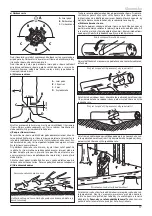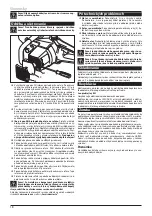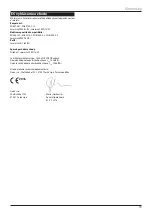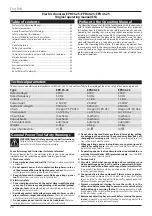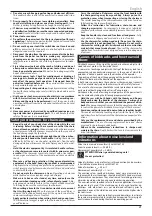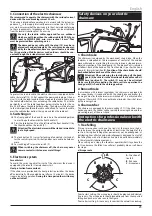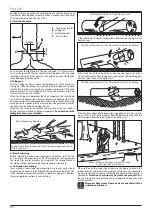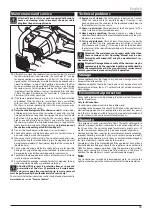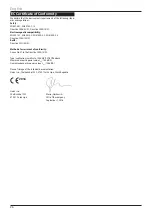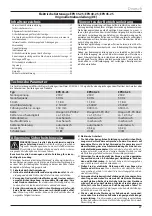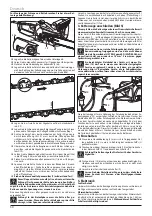
English
21
e)
Do not overreach. Keep proper footing and balance at all times.
This enables better control of the power tool in unexpected situa-
tions.
f)
Dress properly. Do not wear loose clothing or jewellery. Keep
your hair, clothing and gloves away from moving parts.
Loose
clothes, jewellery or long hair can be caught in moving parts.
g)
If devices are provided for the connection of dust extraction
and collection facilities, ensure these are connected and prop-
erly used.
Use of dust collection can reduce dust-related hazards.
4) Power tool use and care
a)
Do not force the power tool. Use the correct power tool for your
application.
The correct power tool will do the job better and safer
at the rate for which it was designed.
b)
Do not use the power tool if the switch does not turn it on and
off.
Any power tool that cannot be controlled with the switch is
dangerous and must be repaired.
c)
Disconnect the plug from the power source and/or the battery
pack from the power tool before making any adjustments,
changing accessories, or storing power tools.
Such preventive
safety measures reduce the risk of starting the power tool acciden-
tally.
d)
Store idle power tools out of the reach of children and do not
allow persons unfamiliar with the power tool or these instruc-
tions to operate the power tool.
Power tools are dangerous in the
hands of untrained users.
e) M
aintain power tools. Check for misalignment or binding of
moving parts, breakage of parts and any other condition that
may affect the power tool’s operation. If damaged, have the
power tool repaired before use.
Many accidents are caused by
poorly maintained power tools.
f)
Keep cutting tools sharp and clean.
Properly maintained cutting
tools with sharp cutting edges are less likely to bind and are easier
to control..
g)
Use the power tool, accessories and tool bits etc. in accordance
with these instructions, taking into account the working con-
ditions and the work to be performed.
Use of the power tool for
operations different from those intended could result in a hazard-
ous situation.
5) Service
a)
Have your power tool serviced by a qualified repair person us-
ing only identical replacement parts.
This will ensure that the
safety of the power tool is maintained.
Safety instructions for chainsaws
–
Keep all parts of your body clear of the chain while the saw
is running. Before starting the saw, make sure that the chain
does not touch any objects.
When working with a chainsaw, even
a short moment of inattentiveness may result in clothes or parts of
the body being caught by the chain.
–
Always hold the chainsaw with your right hand at the rear han-
dle and your left hand at the front handle.
Holding the chainsaw
differently (left hand – rear handle / right hand – front handle)
during operation will increase the risk of injury and is not permit-
ted.
–
Hold the electric equipment by its insulated handle surfaces,
as the chainsaw can come into contact with its own mains pow-
er cable.
If the chainsaw comes into contact with a live cable, it
can energise metal parts of the equipment and cause an electric
shock.
–
Wear eye and hearing protection. Other personal protection
equipment for the head, hands, legs and feet is recommended.
Proper protective clothing and protection equipment reduce the
risk of injury caused by thrown-about wood chips and accidental
contact with the chain.
–
Do not operate the chainsaw on trees.
Operating a chainsaw
while situated on a tree involves a high risk of injury.
–
Make sure to have a safe stand at any time, and only use the
chainsaw when standing on solid, safe and level ground.
A slip-
pery ground or instable surfaces as the steps of a ladder may lead
to loosing balance or the control over the chainsaw.
–
When cutting a branch that is under tension take into account
that it will spring back.
When the tension of the wood fibres is
released the tensioned branch may hit the operator and/or the
chainsaw resulting in a loss of control.
–
Apply particular caution when cutting brush and young trees.
The thin material may get caught in the chain and hit you or throw
you off balance.
–
Carry the switched-off chainsaw using the front handle with
the chain pointing away from your body. A lways put on the
protection cover when transporting or storing the chainsaw.
The careful handling of the chainsaw reduces the risk of acciden-
tally touching the sharp cutting chain.
–
Follow the instructions for lubrication, chain tension and
changing accessories.
An improperly tensioned or lubricated
chain may either break or considerably increase the risk of a kick-
back.
–
Keep the handles dry, clean and free from oil and grease.
Fatty,
oily handles are slippery and may lead to a loss of control.
–
Use the chainsaw for cutting wood only! Do not use the chain-
saw for works it is not designed for. – Example: Do not use the
chainsaw for cutting plastics, brickwork or other construction
materials that are not made of wood.
The use of the chainsaw for
applications, for which it is not designed, may result in dangerous
situations.
Causes of kickbacks and how to avoid
them:
A kickback can occur if the tip of the guide bar touches an object or the
wood to be cut pinches the bar inside the cut.
In some cases, touching an object with the tip of the bar may lead to an
unexpected, sudden backward movement, in the course of which the
guide bar is ‘kicked’ upwards and in the direction of the operator.
The pinching of the chain at the upper edge of the guide bar may fierce-
ly throw the bar back in the direction of the operator.
In both cases, you may loose the control over the saw and get seriously
hurt. Do not exclusively rely on the chainsaw’s built-in safety features.
As a user of a chainsaw you should take several precautions to continu-
ously work without having accidents or suffering injuries.
A kickback is the result of a wrong or improper use of the power tool. It
may be avoided by taking the following proper precautions:
–
Hold the saw with both hands with the thumbs and fingers
firmly embracing the handles of the chainsaw. Position your
body and arms such that you can withstand the power of a kick-
back.
When proper precautions are taken the operator will be able
to control the power of a kickback. Never let go of the chainsaw!
–
Avoid unusual postures and do not cut above shoulder height.
This avoids accidentally touching objects with the tip of the bar
and allows for a better control of the chainsaw in unexpected situ-
ations.
–
Only use the replacement bars and chains prescribed by the
manufacturer.
The use of wrong replacement bars and chains
may lead to chain breaks or kickbacks.
–
Adhere to the manufacturer’s instructions to sharpen and
maintain the chain.
Depth limiters that are too low increase the
risk of a kickback.
Information about noise level and
vibrations
Values were measured in conformity with EN 60745:
Acoustic pressure level L
pA
= 90 dB (A)
Measurement uncertainty K = 3 dB (A)
ATTENTION! Noise is generated during work!
Use ear protection!
Value of vibrations a
h
(sum of vectors in three directions) and uncertain-
ty K established in conformity with EN 60745:
Value of vibrations a
h,D
= 5,0 m/s
2
Measurement uncertainty K = 1,1 m/s
2
The emission values specified (vibration, noise) were measured in ac-
cordance with the test conditions stipulated in EN 60745 and are intend-
ed for machine comparisons. They are also used for making preliminary
estimates regarding vibration and noise loads during operation.
The emission values specified refer to the main applications for which
the power tool is used. If the electric power tool is used for other ap-
plications, with other tools or is not maintained sufficiently prior to
operation, however, the vibration and noise load may be higher when
the tool is used.
Take into account any machine idling times and downtimes to estimate
these values more accurately for a specified time period. This may signif-
icantly reduce the load during the machine operating period.
Summary of Contents for EPR 35 -25
Page 4: ...4 12 11 9 3 2 4 5 6 13 14 15 9 18a 18b 10 16 8 7 17 16 19 20 17 23 22 21 1 14 18 ...
Page 62: ...62 ...
Page 63: ...63 ...











